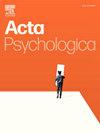皮肤传导反应以及对情绪化面部表情和语言的习惯化。
IF 2.1
4区 心理学
Q2 PSYCHOLOGY, EXPERIMENTAL
引用次数: 0
摘要
皮肤传导反应(SCR)是交感神经激活的可靠标记,用于测量情绪唤醒。本研究探讨了呈现方式(面部或词语)对 SCR 引起的情绪辨别程度的影响。研究人员对 102 名参与者进行了研究,研究了与六种基本情绪--愤怒、快乐、厌恶、恐惧、悲伤和惊讶--相关的面部表情或词语。对这些刺激的主观唤醒评分能准确预测 SCR 的振幅,但情绪评分却不能预测 SCR 的振幅。连续六次出现的情绪刺激和中性刺激的习惯化过程以指数衰减函数为特征,该函数捕捉了 SCR 反应相对于同一刺激的前一次试验的减弱速度。通过从情绪诱发的 SCR 中减去对中性刺激的反应,可以证明每种情绪的最初呈现都会引起很大的反应,尤其是情绪内容。值得注意的是,对表达快乐、厌恶和悲伤的面孔的初始情绪反应超过了对表达相同情绪的词语的反应。结果表明,不同的情绪反应可以通过简单的电子仪器进行量化。本文章由计算机程序翻译,如有差异,请以英文原文为准。
Skin conductance response and habituation to emotional facial expressions and words
Skin conductance response (SCR) serves as a dependable marker of sympathetic activation used to measure emotional arousal. This study investigates the impact of presentation modality (face or word) on the degree of emotional discrimination elicited by SCR. Facial expressions or words associated with six basic emotions—anger, happiness, disgust, fear, sadness, and surprise—were studied among 102 participants. The amplitude of SCR was accurately predicted by subjective arousal ratings of these stimuli, but not by valence ratings. The habituation process to emotional and neutral stimuli across six successive presentations was characterized by an exponential decay function, capturing the rate at which SCR response diminishes in relation to the preceding trial of the same stimulus. Through the subtraction of the response to neutral stimuli from the emotion-evoked SCR, it was demonstrated that the initial presentation of each emotion elicits a substantial response, particularly attributable to the emotional content. Notably, the initial emotional response to faces expressing happiness, disgust, and sadness surpassed that of words conveying the same emotions. The results indicate that different emotional responses can be quantified using a simple electrical instrument.
求助全文
通过发布文献求助,成功后即可免费获取论文全文。
去求助
来源期刊

Acta Psychologica
PSYCHOLOGY, EXPERIMENTAL-
CiteScore
3.00
自引率
5.60%
发文量
274
审稿时长
36 weeks
期刊介绍:
Acta Psychologica publishes original articles and extended reviews on selected books in any area of experimental psychology. The focus of the Journal is on empirical studies and evaluative review articles that increase the theoretical understanding of human capabilities.
 求助内容:
求助内容: 应助结果提醒方式:
应助结果提醒方式:


